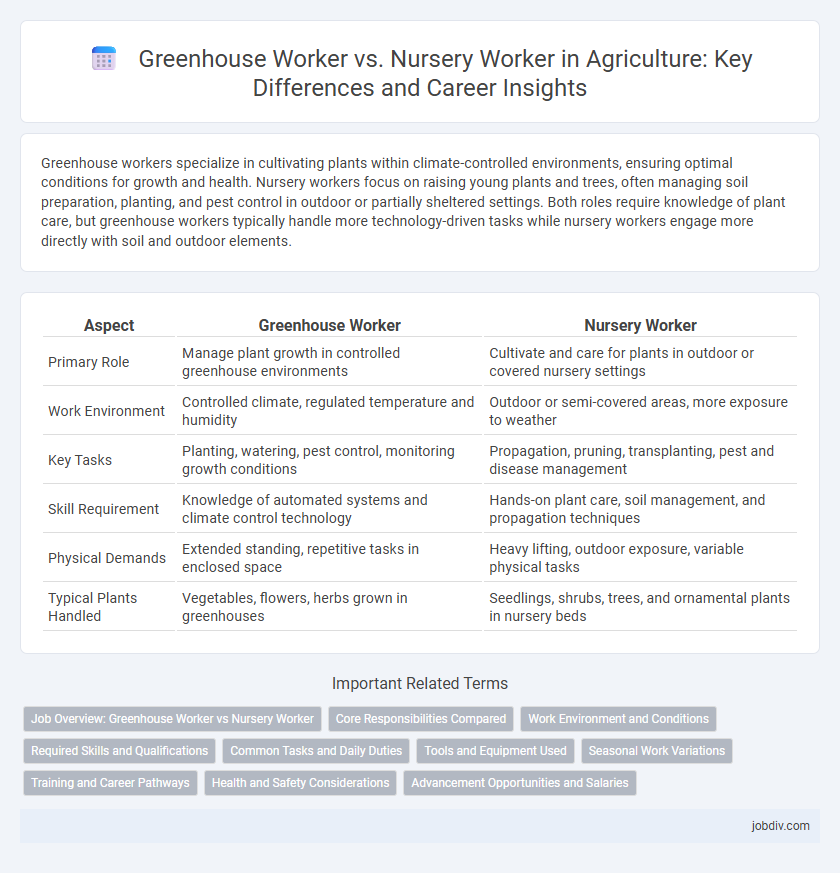Greenhouse workers specialize in cultivating plants within climate-controlled environments, ensuring optimal conditions for growth and health. Nursery workers focus on raising young plants and trees, often managing soil preparation, planting, and pest control in outdoor or partially sheltered settings. Both roles require knowledge of plant care, but greenhouse workers typically handle more technology-driven tasks while nursery workers engage more directly with soil and outdoor elements.
Table of Comparison
| Aspect | Greenhouse Worker | Nursery Worker |
|---|---|---|
| Primary Role | Manage plant growth in controlled greenhouse environments | Cultivate and care for plants in outdoor or covered nursery settings |
| Work Environment | Controlled climate, regulated temperature and humidity | Outdoor or semi-covered areas, more exposure to weather |
| Key Tasks | Planting, watering, pest control, monitoring growth conditions | Propagation, pruning, transplanting, pest and disease management |
| Skill Requirement | Knowledge of automated systems and climate control technology | Hands-on plant care, soil management, and propagation techniques |
| Physical Demands | Extended standing, repetitive tasks in enclosed space | Heavy lifting, outdoor exposure, variable physical tasks |
| Typical Plants Handled | Vegetables, flowers, herbs grown in greenhouses | Seedlings, shrubs, trees, and ornamental plants in nursery beds |
Job Overview: Greenhouse Worker vs Nursery Worker
Greenhouse workers specialize in cultivating plants within controlled environments, managing temperature, humidity, and light to optimize growth for flowers, vegetables, and herbs. Nursery workers primarily focus on propagating young plants, trees, and shrubs in outdoor or indoor nursery settings, ensuring healthy seedlings for transplantation. Both roles require knowledge of plant care but differ in their environmental management and cultivation stages.
Core Responsibilities Compared
Greenhouse workers specialize in cultivating and maintaining plants within controlled environments by managing temperature, humidity, and light to optimize growth. Nursery workers focus on propagating, transplanting, and caring for young plants, trees, and shrubs in outdoor or sheltered settings, ensuring proper soil conditions and pest control. Both roles require detailed knowledge of horticultural practices but differ primarily in environmental management and plant developmental stages.
Work Environment and Conditions
Greenhouse workers operate in controlled indoor environments with regulated temperature, humidity, and light, promoting optimal plant growth year-round. Nursery workers typically work outdoors or in partially sheltered areas, exposing them to varying weather conditions and seasonal fluctuations. Both roles demand physical labor, but greenhouse workers experience more stable climate conditions compared to nursery workers facing natural environmental challenges.
Required Skills and Qualifications
Greenhouse workers require skills in climate control, pest management, and monitoring plant health, often needing certifications in horticulture or agricultural technology. Nursery workers must have expertise in plant propagation, soil preparation, and irrigation systems, with qualifications typically including agricultural training or experience in plant care. Both roles demand physical stamina, attention to detail, and knowledge of safety protocols to ensure optimal plant growth and workplace safety.
Common Tasks and Daily Duties
Greenhouse workers manage climate control, watering, fertilizing, and pest management to ensure optimal plant growth in controlled environments. Nursery workers propagate plants, transplant seedlings, prune, and maintain young plants for sale or distribution, often focusing on outdoor or semi-outdoor settings. Both roles require plant health monitoring, data recording, and adherence to safety protocols to maximize productivity and crop quality.
Tools and Equipment Used
Greenhouse workers primarily use climate control systems, ventilation fans, and automated watering systems to maintain optimal growing conditions for plants within enclosed environments. Nursery workers rely on hand tools like pruners, shovels, and wheelbarrows for planting, transplanting, and soil preparation in outdoor settings. Both roles utilize irrigation equipment and protective gear, but greenhouse work demands more technology-driven tools to regulate temperature and humidity.
Seasonal Work Variations
Greenhouse workers experience fluctuations in workload aligned with planting cycles and climate control needs, often facing intense periods during seeding and harvesting seasons within controlled environments. Nursery workers encounter seasonal peaks tied to outdoor planting schedules and retail demand for plants, with increased activity in spring and fall for propagation and sales. Both roles require adaptability to temperature and light conditions, yet greenhouse roles emphasize consistent climate management, while nursery work depends heavily on natural seasonal changes.
Training and Career Pathways
Greenhouse workers typically receive specialized training in controlled environment agriculture, focusing on climate regulation, pest management, and hydroponics, which prepares them for careers in advanced horticulture and facility management. Nursery workers often gain skills in plant propagation, soil preparation, and pest control through on-the-job training or vocational programs, leading to roles in landscape supply, retail nurseries, or plant production management. Both pathways offer opportunities for advancement into supervisory positions, agriculture technology roles, or agribusiness entrepreneurship with additional certification or education.
Health and Safety Considerations
Greenhouse workers face unique health risks such as exposure to pesticides, high humidity, and repetitive strain injuries from handling plants and equipment in enclosed environments. Nursery workers encounter health concerns including heavy lifting injuries, prolonged standing, and allergen exposure from soil, plants, and fertilizers in open or semi-enclosed spaces. Both roles require strict adherence to personal protective equipment (PPE) use, ergonomic practices, and regular training on hazard identification to maintain optimal health and safety standards.
Advancement Opportunities and Salaries
Greenhouse workers often have greater advancement opportunities due to the specialized skills required for managing controlled environments, leading to roles such as greenhouse manager or horticulture technician with salaries averaging between $30,000 and $50,000 annually. Nursery workers typically start in entry-level positions focused on plant propagation and maintenance, with potential growth into nursery supervisor or retail manager roles, where salaries range from $28,000 to $45,000 per year. Both career paths offer room for advancement, but greenhouse roles generally command higher wages due to technical expertise and operational responsibilities.
Greenhouse Worker vs Nursery Worker Infographic

 jobdiv.com
jobdiv.com